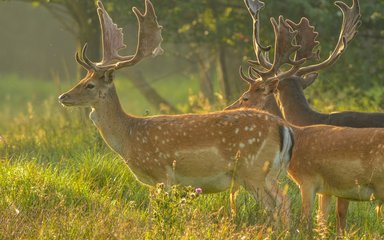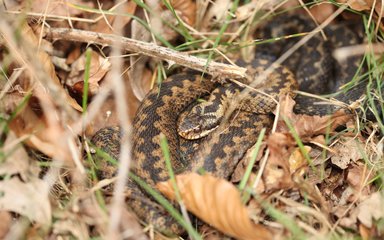Meet the special species of Haldon Forest Park
Haldon Forest Park is alive with wildlife among the trees, above our heads, and below our feet. We have gathered together five of our favourite species that make Haldon Forest a special place for nature. How many are you familiar with?
You can do your bit for wildlife when visiting Haldon by sticking to waymarked paths and keeping dogs out of the undergrowth. This is important all year round as birds, reptiles, and mammals are breeding during different seasons. We're always keen to hear about the wildlife you spot on your forest visits. Drop us a line to haldon.rangers@forestryengland.uk.
1. Nightjar
The European Nightjar (Caprimulgus europaeus) is a nationally rare bird. They spend most of the year in Africa, migrating to European countries including the UK to breed during the summer. Nightjar numbers fell dramatically during the 20th century as heathland breeding habitat was lost. But as the value of this habitat is recognised across the country, numbers are slowly recovering. Nightjars are found across many rural sites in Devon and the south west, and they are especially important to Haldon. The forest alone is home to around 1% of the national breeding population.
Nightjar are nocturnal and feed on insects and invertebrates. They are most active at dusk and dawn, when they hunt for moths and beetles on the wing, darting silently and snatching them from the air. Their outstanding camouflage makes them difficult to spot but their calls are very recognisable. Listen out for the male’s territorial churr-ing call and a ‘coo-ick’ contact call which is made by both sexes.
Nightjar lay their eggs on the ground, putting them at greater risk from predators and human disturbance than birds who nest in trees and hedges. The nightjar’s excellent camouflage makes them very difficult to spot and avoid even in daylight, so you can help to protect them by keeping yourself and your dogs on official paths.
Did you know that the nightjar’s Latin name derives from its mythical ability to steal milk from goats?
2. Dormouse
The immediately-recognisable dormouse (Muscardinus avellanarius) is native to the UK but habitat loss has seen their numbers decline sharply in recent decades. The species is protected under UK and European law, and a special license is required to disturb or handle them. Dormice are also special because their presence can be an indicator of biodiversity and good woodland management. Habitats which are good for dormice also benefit woodland birds, bats, and butterflies.
Dormice live, feed, and reproduce in trees, hedges, and scrub. They rely on well-connected areas of varied undergrowth to make their homes, find food, and raise their young. There are many areas of dormouse-friendly habitat around Haldon Forest, which we improve wherever we can, and ensure that we only do this work outside the important dormouse breeding season during the summer.
As autumn arrives, dormice build up winter fat reserves ready for hibernation. When the temperature drops, they move closer to ground level to build a winter nest. This puts them at risk of being disturbed by dogs snuffling in the undergrowth, so you can help by keeping dogs close by during your walk.

3. Deer
The UK has six species of deer, two of which are a common sight in Haldon Forest. Deer are one of England’s largest wild mammals, roaming across a range of landscapes and habitats, including the nation’s forests. Deer play an important role in the forest ecosystem by maintaining open areas with their browsing and roaming, and encouraging biodiversity.
Fallow deer are easy to identify by their antlers, which are shaped like the palm of a hand with small points. Fallow deer coats are generally pale in colour but some of the fallow deer in Haldon have the less common melanistic coat, which is almost entirely deep brown or black. Roe deer are one of the smaller deer species in England’s forests, a black nose with a white chin, and small and simple antlers, typically with three points on each.
Deer in the forest
Numbers of deer in Britain are at an all-time high because they have no natural predators, such as lynx, bears, or wolves. Where the number or concentration of deer starts to produce a negative impact on the ecosystem, our highly skilled wildlife rangers replace the role of missing predators by humanely controlling deer populations in the forests. We work with industry partners to supply wild venison to the UK market so that this by-product of forest management does not go to waste.
Although deer are instinctively shy, the deer in Haldon Forest can often be seen by visitors and have even been known to graze around the car park at the A38 service station! Learn how to spot them for yourself with our top tips.
4. Adder
The UK’s only venomous snake, the adder (Vipera berus), has suffered from undeserved negative press for many years. Adders are shy creatures who prefer to slither away when disturbed and only bite to subdue their small prey, or when trodden on or picked up. Adders can be identified from the distinctive zigzag pattern along their back and are most easily spotted (from a polite distance) on a sunny spring or summer day when they can be seen basking in sheltered spots.
Adders at Haldon
Like other species that favour well-draining heath habitats, adders have been in decline for many decades. Haldon Forest does not have a large adder population but we have an increasing area of ideal adder habitat which we are working to protect and improve. We are also working to make these areas better connected, which is important for species – not just adders – to move and breed.
As a cold-blooded species, adders prefer spaces where they can bask in the sun, such as sheltered southerly heath. Unlike the majority of snakes, female adders do not lay eggs but give birth to live young in the late summer. As temperatures drop in the autumn, adders look for sheltered spots to hibernate for the winter, known as hibernacula. Around Haldon Forest, we maintain a number of natural and man-made hibernacula to help our adders remain safe and healthy through the winter.


5. Pearl-bordered fritillary
Many of England’s butterfly species have been in sharp decline due to loss of habitat, poorly connected habitats, and climate change. But woodlands still provide a place to breed for three-quarters of our butterfly species. At Haldon Forest, we work closely with experts at Butterfly Conservation to monitor our butterfly species, and maintain and improve important habitats to support them.
Some of our work involves managing verges to allow caterpillar-friendly food plants to thrive, or identifying areas of good habitat and making them better connected so populations can travel between them.
Enjoy Haldon's butterflies
Our Butterfly Walking Trail crosses through one of our main butterfly areas where more than 30 species have been recorded, including the scarce pearl-bordered fritillary. This small and beautiful butterfly can be spotted flying close to the ground during May and June, feeding from plants including bugle. Also look out for large silver-washed fritillary zooming up forest rides, speckled wood defending patches of sunshine, and gatekeeper basking .



